java程序设计第四讲教案
Java程序设计 教学课件 作者 焦玲 JAVA课件--第四章(102页)

■ Students为已经指定存在的类,s1为对象名。
■ Students类中声明了number、name、nClass 三个成员 变量以及getNumber、getName、getClass 三个成员方 法。由于变量s1的类型是Students,所以s1也就具有了 Stuents类中声明的上述三个成员变量作为它的属性,以 及三个成员方法作为它的状态。
■ 1、对象的创建
❏ 类实例化之后就可以产生多个对象,由类所创建 的这多个对象都具有类所定义的那些属性和行为。
❏ 然而,由同一个类所创建的不同对象的同一个属 性的值可能不同。
❏ 比如,可以定义一个学生类,它有姓名、班级、 出生年月等属性。学生类可以创建如下若干个学 生对象。如图4-1所示。
学生类
创建多个对象
❏ Java是一个面向对象的程序设计语言,我们在前面所看到 的每一个例题都使用了关键字“class”,它就是面向对象 程序设计方法中所使用的“类”。作为程序设计人员,我 们需要从现实生活中抽象出类和对象,然后将类和对象应 用到我们的编程中来解决实际问题。
4.1.2 类与对象的概念
■ 1、类的概念
❏ 将具有共同特征和行为的对象归为一个“类”,如 现实生活中的“汽车”类、“动物”类、“人”类 等。
❏ 针对任何一个方法,返回类型是必须的,如果方法没有返回值,则 返回类型为void。否则返回类型可以是各种数据类型,如int、float、 String等。
❏ 修饰符可以是static、public、private、protected等,我们将后面详 细讲解。
❏ 参数表中的参数主要用于参数传递,称之为形式参数。相邻的两个 参数之间用逗号隔开,每个参数的格式如下:
java程序设计 教学 教案 课件 04_4
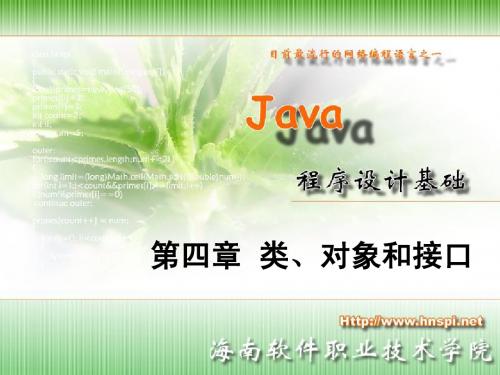
4.5 包
程序如果使用了包语句,就必须有相应的目录 结构。 如: package tom.jafei; 则目录结构必须包含如下结构: ……\tom\jiafei
4.5 包
例6: package tom.jiafei; public class Example4_6 { public static void main(String args[]) { System.out.println("我有包名"); } }
第四章 类、对象和接口
4.2 对象
类是创建对象的模板 • 创建对象:
– 对象的声明 – 为对象分配内存
4.2 对象
1、对象的声明:
– 格式:类的名字 对象名字; – 如:People zhangPing;
4.2 对象
2、为声明的对象分配内存:
– 使用new运算符和类的构造方法为声明的对象分 配内存,如果类中没有构造方法,系统会调用默 认的构造方法(默认的构造方法是无参数的)。
4.2.3 对象的应用和实体
class Example { public static void main(String args[]) { 圆 circle=new 圆(10); 圆锥 circular=new 圆锥(circle,20); System.out.println("圆锥底圆半径:"+circular.获取底圆半径()); System.out.println("圆锥的体积:"+circular.计算体积()); circular.修改底圆半径(100); System.out.println("圆锥底圆半径:"+circular.获取底圆半径()); System.out.println("圆锥的体积:"+circular.计算体积()); } }
Java电子教案第4章精品PPT课件

图4.2 JAVA常用GUI组件
4.2 AWT和Swing
AWT
抽象窗口工具包AWT (Abstract Window Toolkit) 是 Java 提供的建立图形用户界面GUI (Graphics User Interface)工具集,可用于生成现代的、鼠标控制的图 形应用接口,并且可以无需修改,就可以在各种软硬件 平台上运行。
java.awt包中提供了GUI设计所使用的类和接口,提供了 各种用于GUI设计的标准类,图4.3显示了AWT中主要类之 间的关系。由图可知,AWT中的类按其功能的不同可分为 5大类。 图4.3 AWT类层次
基本GUI组件类
➢ Java的图形用户界面的最基本组成部分是组件 (Component),组件是一个可以以图形化的方式 显示在屏幕上并能与用户进行交互的对象,例如一 个按钮,一个标签等。组件不能独立地显示出来, 必须将组件放在一定的容器中才可以显示出来。用 来提供人机交互的基本控制界面
基本图形类
➢ 用于构造图形界面的类,如字体类(Font)、绘图 类(Graphics)、图像类(Image)和颜色类(Color) 等
Swing
组件从功能上分可分为
顶层容器:JFrame、JApplet、JDialog和JWindow共4个。
中间容器:JPanel、JScrollPane、JSplitPane和JToolBar。
和JButton 4.6 HappyChat登录界面 4.7 本章小结 4.8 上机实训
4.1 HappyChat登录界面分析
HappyChat聊天系统的登录程序用于实现用户登录, 已注册用户通过输入用户名和口令在聊天服务器端 进行验证,完整界面如图4.1所示
Java的广泛应用,除归因于其强大的跨平台特性、 完善的安全机制及其分布式计算等特性外,Java提 供的丰富的图形类库也是功不可没。良好的GUI可 以让程序更具有吸引力、更好操作、更容易学习。 Java可以通过图4.2所示的GUI组件进行应用程序界 面的设计
第四讲 java类与对象

方法重载
访问权限
类和对象
对象表示现实世界中某个具体的事物。 抽象是从特定的实例中抽取共同的性质以形成一般化
概念的过程。 对象具有两方面的含义:
在现实世界中:
是客观世界中的一个实体 是一个可标识的存储区域
在计算机世界中:
类
类是用来描述一组具有共同状态和行为的对象的原型,
//App4_10.java Public class App4_10{ Pulbic static void main(String[] args){ Circle circle=[代码1] //创建circle对象 [代码2] Circular circular= /*创建circular对象,并将circle引用 传递给构造方法的参数c。*/ System.out.print(“圆锥的体积:%5.5f\n”,circular.getVolme); Circular.bottom.radius =100; System.out.printf(“圆锥的面积: %5.5f\n”,circular.getVolme); } } 执行[代码1]: Circle circle=new Circle(); 执行[代码]: Circular circular=new Circular(circle,20);
对象的组合
一个类的成员变量可以是某个类声明的变量,即可以是对象。当A类把B类的对象作为自已 的成员时,称A类的对象组合了B类的对象。比如:公司组合了员工,收音机组合了电池 //Circle.java Public class Circle{ Double radius; Circle(double r){ Radius=r; } Double getArea(){ return 3.14*radius*radius; } }
java第4章PPT教学课件

2020/12/12
2020/12/12
3
图示:类与对象的关系
2020/12/12
4
4.2 面向对象软件开发的基本过程
1、面向对象的软件开发过程 2、面向对象的分析阶段 3、面向对象的设计阶段 4、实现阶段
2020/12/12
5
1、面向对象的软件开发过程ቤተ መጻሕፍቲ ባይዱ
用面向对象的方法来解决实际问题,是一个比较复 杂的过程,它包括面向对象的分析(OOA)、面向对象的 设计(OOD)和面向对象的编程(OOP)。
这些需求进行分析和筛选,与用户协商,去掉用户的需求中 的不合理元素,形成一个合理的方案。
需求分析的过程是一个复杂、烦琐、甚至艰难的过程, 通常需要反复讨论、协商和修改,才能达成最后的一致。需 求分析非常重要,如果做的不好, 会形成隐患和障碍,影响
整个开发工作。需求分析最后应形成书面的需求陈述。
2020/12/12
2020/12/12
2
2、什么是类
在Java程序中,类是创建对象的模板,对象是类的实例, 任何一个对象都是隶属于某个类的。
类是同种对象的集合与抽象。分类所依据的原则是抽象, 即抽象出能反映与当前目标有关的本质特征,而忽略那些与当 前目标无关的非本质特征,从而找出事物的共性,把具有共同 性质的事物归结为一类,得出一个抽象的概念——类。
6
图示
2020/12/12
《java程序设计》第4讲精品PPT课件
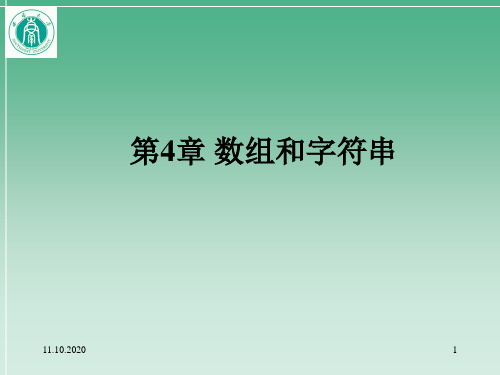
11.10.2020
11
(3)引用一维数组元素
下标
数组名
0 1 5 3 4 5 6 7 8 9 10 11 12 13 14
arrLeabharlann -28 -1 -3 16 20 25 16 16 8
1 8
19 45 21 -2
内容
• 数组的每个元素通过它在数组里的位置 来引用:数组名 [ 下标 ],例如:arr[7]
• 使用一个不在0到N-1范围内的下标值系统将 发生运行时异常,这是由于Java运行系统会 对数组下标自动进行范围越界检查。例如: arr[-1]、arr[15]
• 11.10.2020 例4.1
13
• 对数组的处理通常与循环语句结合在一起,实 现对数组元素依次作出某种处理。例如:
int myArray[ ] = new int[5]; for ( int index = 0; index < myArray.length;
11.10.2020
16
• 对于对象数组来说,Java只把对象的引用存储 在数组里,而不是存储整个对象。
cou1n5t = 0
• 当创建有N个元素的数组时,编译器为N个该 元素类型的变量分配空间;对于元素是引用类 型的数组,编译器将分配N个地址的空间。
例如:double arr[ ] = new double[20]; // 编译器将分配20*8个字节的存储空间 String strarr[ ] = new String[5]; // 编译器将分配5*4个字节的存储空间
strarr[k] = new String( );
strarr
strarr
strarr
11.10.2020
:vcaoSluutnre:vcitnaoS==lugut“nr0e:vc”itnaoS==lugut“nr0e:vc”itnaoS==lugut“nr0e:v”itnaS==lgut“r0e”in=g“”
第四讲 抽象、封装与类

Java Program Design &Object Oriented Methodology
第四讲 抽象、封装与类 主讲教师: 王海峰 临沂大学信息学院网络教研室
gadfly7@
1
回顾上讲 • • • • Java基本数据类型 变量、常量、表达式 各种运算,优先级 程序流程控制
调节亮度
……;} }
Copyright © 2006 , Wang Hai feng, All rights reserved
13
4.2 Java 的类
import java.awt.Graphics; /**
* This class is used to draw a box .
* * @author hf_wang */ class Box { double width,height,depth; double volume( ) { return width*height*depth;
private修饰符表示该成员变量只能被该类本身访问,任何其他类都不能访 问该成员变量。 不加任何访问权限限定的成员变量属于默认访问权限。默认访问权限表示 该成员变量只能被该类本身和同一个包的类访问(friendly)。 protected修饰符表示该成员变量除可以被该类本身和同一个包的类访问外, 还可以被它的子类(包括同一个包中的子类和不同包中的子类)访问。 public修饰符表示该成员变量可以被所有类访问
Copyright © 2006 , Wang Hai feng, All rights reserved 28
16
成员变量设计: • 确定变量的数据类型:
– 运动员类的心率?Int\ float; – 银行帐号的利率?Int\ float;
JAVA程序设计_教案

JAVA程序设计_教案教案:JAVA程序设计课程目标:1.了解JAVA的基本结构和语法;2.掌握JAVA的常用数据类型和运算符;3.能够编写简单的JAVA程序;4.培养学生的编程思维和解决问题的能力。
教学内容:第一课:JAVA基础知识介绍(20分钟)1.什么是JAVA?2.JAVA的特点及应用领域。
3.JAVA开发工具的选择和安装。
4.第一个JAVA程序。
第二课:JAVA基本语法(30分钟)1.变量的声明和赋值。
2.数据类型和运算符。
3. 流程控制结构:if-else 语句、switch-case 语句、for 循环、while 循环。
4.函数的定义和调用。
第三课:面向对象编程(40分钟)1.类和对象的概念。
2.类的属性和方法。
3.构造方法和析构方法。
4.封装、继承和多态。
5.类的继承和实现接口。
第四课:字符串和数组(30分钟)1.字符串的基本操作:连接、比较、截取、替换。
2.数组的定义和初始化。
3.数组的访问和遍历。
4.常见的数组操作:排序、查找、插入、删除。
第五课:异常处理(20分钟)1.异常处理的概念和作用。
2. try-catch-finally 语句的使用。
3.自定义异常类。
第六课:文件操作(30分钟)1.文件的读取和写入。
2.文件的创建、删除和重命名。
3.文件的复制和移动。
教学方法:1.理论教学结合实际案例,让学生能够将所学知识应用到实际问题中。
2.引导学生主动思考和解决问题,培养学生的自学能力和解决问题的能力。
3.引入互动环节,让学生参与到教学中来,激发学生的兴趣和积极性。
教学工具:1.讲义和教材。
2.电脑、投影仪和黑板。
3. JAVA 开发工具(如 Eclipse 或 IntelliJ IDEA)。
评估方式:1.课后作业:每堂课布置合适的编程作业,考察学生对所学知识的掌握和应用能力。
2.课堂练习:在课堂上通过问答、小组讨论等方式进行互动,检验学生对知识的理解和运用能力。
3.期末考试:根据教学内容和目标,出一份综合性的考试,测试学生的综合能力。
Java程序设计标准教程ppt第4章

4.1 类和对象
(9)重载(overload) 重载就是用户可能根据需要设计具有相同名字的多个方法,
但使用时可以带不同的数据类型。这样做的好处就是提供了 代码的可读性,通常我们根据方法的功能来定义其名称,这 样很可能发生一些不必要的冲突。但有了重载的概念后,只 要各方法的参数表不同,就可根据参数类型的区别来选择正 确的方法,使这些同名、同功能的方法可以对不同的数据进 行恰当的操作。
用户程序自定义的类是用户在程序设计过程中,为解决某一 特定问题而自己定义的类。类是Java语言的基本组成单元。 类的一个重要作用就是定义了一种新的数据类型,一旦该数 据类型被定义,就可以利用它来创建新的对象。
类是通过关键字class来定义的,它的一般语法格式如下: [类修饰符] class 类名称 [extends 类] [implements
面向对象程序设计的基本原理是:对要处理的问题实现自然 分割,按照通常的思维方式建立问题领域的模型,设计尽可 能自然地表现问题求解的程序。
Java语言是一种完全对象化、结构严谨的语言,它通过类、 对象等概念来组织和构建整个程序,因此,掌握面向对象程 序设计的基本概念和方法是学习Java编程的前提和基础,下 面就先介绍面向对象编程中的几个基本概念。
(2)class是类的说明关键字。 (3)类名称是用户定义的Java标识符,每个类说明中必须有
class关键字和类名称。 (4)extends关键字用于说明用户定义类继承的直接父类。 (5)implements关键字用于说明用户定义的类将实现哪些接
口。 (6)在类的定义中,第一行是类头部分,由一对大ห้องสมุดไป่ตู้号扩括
例如: import java.awt. *; import java.applet.Applet; 在程序的开始处声明了这些语句之后,在接下来的Java程序
(教案)Java语言程序设计_教案56学时_第4章

第4章类与对象的4.4节-4.6节,本次课是第4章的第2次课。
基本内容:❖类与程序的基本结构❖参数传值❖对象的组合重点类与程序的基本结构、参数传值。
难点参数传值、尤其是引用类型参数的传值。
§4.4 类与程序的基本结构一个Java应用程序(也称为一个工程)是由若干个类所构成,这些类可以在一个源文件中,也可以分布在若干个源文件中,如图4.12所示。
例子5 中一共有三个Java源文件(Example4_5.java Rect.java Lader.java ,需要打开记事本三次,分别编辑、保存这三个Java源文件),其中Example4_5.java是含有主类的Java 源文件。
Java应用程序从主类的main方法开始执行。
在编写一个Java应用程序时,可以编写若干个Java源文件,每个源文件编译后产生一个类的字节码文件。
Rect.javapublic class Rect {double width; //矩形的宽double height; //矩形的高double getArea() {double area = width*height;return area;}}Lader.javapublic class Lader {double above; //梯形的上底double bottom; //梯形的下底double height; //梯形的高double getArea() {return (above+bottom)*height/2;}}Example4_5.javapublic class Example4_5 {public static void main(String args[]) {Rect ractangle = new Rect();ractangle.width = 109.87;ractangle.height = 25.18;double area=ractangle.getArea();System.out.println("矩形的面积:"+area);Lader lader = new Lader();lader.above = 10.798;lader.bottom = 156.65;lader.height = 18.12;area = lader.getArea();System.out.println("梯形的面积:"+area);}}§4.5 参数传值方法中最重要的部分之一就是方法的参数,参数属于局部变量,当对象调用方法时,参数被分配内存空间,并要求调用者向参数传递值,即方法被调用时,参数变量必须有具体的值。
Java程序设计基础教程教学课件U4

多态的用法
修改Cat类,增加同名成员变量color方法eat()
8
super关键字的用法
9
访问父类同 名成员变量
• super.成员变量
访问父类同 名成员方法
• super.成员方法 ([参数列表])
访问父类 构造方法• 来自uper([参数列 表])修改Animal类和Cat类
10
final关键字的用法
//常量声明 //方法声明 }
例 如 , 定 义 一个 Shape 接 口 , 在 该接 口 中定 义 一个 常 量 PI 、 两 个方 法 getArea()和getCircumference(),代码如下:
public interface Shape { final float PI=3.14f; public float getArea(float r); public float getCircumference(float r);
子类SoftwareTeacher,重写父类Teacher的teach()方法 27
重载(Overloading)和重写(Overiding)的区别
28
方法名
权限
• 重载方法名称相同, 参数的类型或个数不 同;而重写方法名称、 参数类型、返回值类 型全部相同
• 重载对方法的权限没 有要求,而被重写的 方法不能拥有更严格 的权限
} class Bread extends Food{ }
抽象方法
14
在抽象类中只做声明而不去实现的方法称为抽象方法,抽象方法只有方法的声明,而没 有方法的实现代码,需要子类重写抽象方法,定义抽象方法的语法格式如下:
abstract <方法返回值类型> 方法名([参数列表]);
Java程序设计课程教案

4.4 课后作业:
编写一个Java程序实现一个简单的集合操作,包括添加、删除和遍历
编写一个Java程序实现一个简单的字典(Map)应用,包括添加、删除和查找
第五章:Java输入输出流
5.1 课程目标:
掌握Java语言的输入输出流编程ห้องสมุดไป่ตู้
学会使用Java语言中的常用输入输出流类
8.1 课程目标:
理解数据库编程的基本概念
掌握Java语言中的数据库编程技术
8.2 教学内容:
数据库编程的基本概念:数据库、表、SQL语言
Java中的数据库编程:JDBC API、数据库连接、SQL语句的执行
数据库操作:数据查询、数据更新、数据删除、数据插入
8.3 教学方法:
通过讲解和实例来引导学生理解数据库编程的概念和用法
掌握Java语言中的企业级应用开发技术
10.2 教学内容:
企业级应用开发的基本概念:Web应用、Web服务、企业服务
Java中的企业级应用开发:Servlet、JSP、Java EE、Web服务、消息服务
常用企业级开发框架:Spring、Hibernate、MyBatis
10.3 教学方法:
通过讲解和实例来引导学生理解企业级应用开发的概念和用法
通过编程实践来掌握Web应用和Web服务的实现
10.4 课后作业:
编写一个Java程序实现一个简单的Servlet应用
编写一个Java程序实现一个简单的Web服务
重点和难点解析
一、Java简介
补充说明:详细阐述Java语言的跨平台性、面向对象、简单易学等特点。解释Java程序是如何通过类和对象来组织代码,以及JVM如何加载和运行Java程序。
《Java语言程序设计》教案-第4章 方法
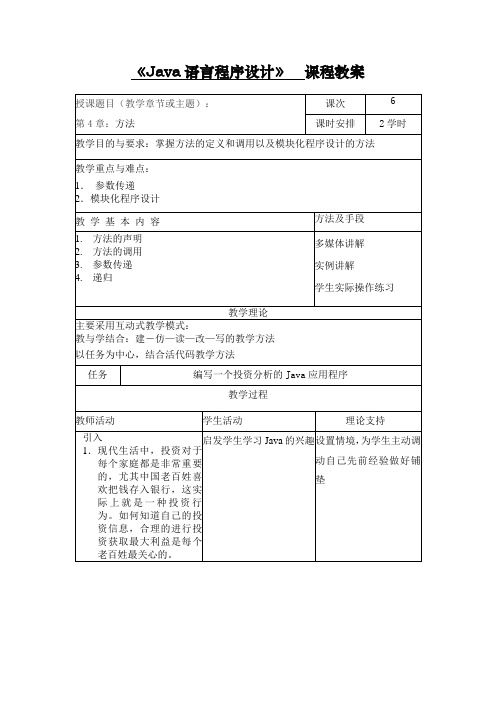
2.带参的方法
还是上例,如果每个方法所需数据在main方法中给出,这是需要参数。
实参和行参的概念
演示编写一个带参方法的声明及调用
观察教师的如何把四个单独程序放在一个Java应用程序中,学习结构化程序设计思想
观察教师的如何通过参数在方法间传递数据,理解方法的参数意义,并学会使用带参的方法的定义
启发学生学习Java的兴趣
设置情境,为学生主动调动自己先前经验做好铺垫
通过实践加深和掌握所学知识,培养学生自己编写代码的能力;
坚持学生是学习的主体的教学理念,为学生的自主学习和探究学习创造机会
鼓励学生勇于尝试满足学生成就感
新课:
1.无参的方法
沿用前面的四个单独的投资分析程序,如何把它们放到一个Java应用程序中?
《Java语言程序设计》课程教案
授课题目(教学章节或主题):
第4章:方法
课次
6
课时安排
2学时
教学目的与要求:掌握方法的定义和调用以及模块化程序设计的方法
教学重点与难点:
1.参数传递
2.模块化程序设计
教声明
2.方法的调用
3.参数传递
4.递归
多媒体讲解
实例讲解
学生实际操作练习
学生自己把剩下的方法修改为带参方法实现
学生演示程序运行过程
总结:教师和学生共同总结
总结操作过程中的问题,说明自己作品中的得意之处,需改进之处,以及技术应用
改善教学过程中的师生、生生之间的有效互动和多边交流
作业
上交电子版资料:
资料内容包括:(1)java的历史和现状(2)什么是java?与你所熟知的语言(C,visual C++,visual Basic等)有何不同,有什么优点?(3)你认为java能干什么?你认为学习java应学些什么?你这学期想学到些什么?
第4章 类与对象
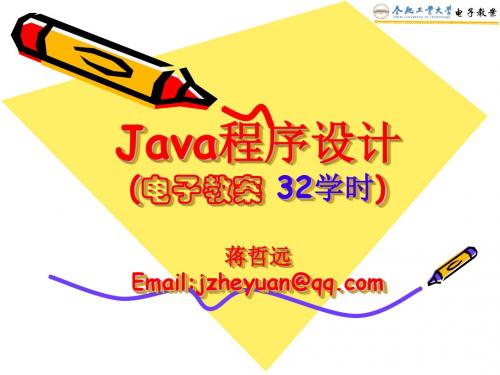
5/78
§4.2
类
类是组成Java程序的基本要素。类封装了一类对 象的状态和方法。类是用来定义对象的模板。 类的实现包括两部分:类声明和类体。基本格式 为:
class 类名 {
类体的内容 }
《Java程序设计》电子教案
6/78
§4.2.1
类声明
类声明 :class 类名
《Java程序设计》电子教案
10/78
§4.2.3 成员变量和局部变量
3.实例变量与类变量:在声明成员变量时,用关键字static给 予修饰的称作类变量(静态变量) ,否则称作实例变量(对象 变量。
类变量是所有对象共有,其中一个对象将它值改变,其他对象得到的就 是改变后的结果;而实例变量则属对象私有,某一个对象将其值改变,不 影响其他对象。例如:
《Java程序设计》电子教案
17/78
§4.2.8
几个值得注意的问题
1.对成员变量的操作只能放在方法中,方法可以
对成员变量和该方法体中声明的局部变量进行操作。
例如: Class A { int a=12; float b=12.56f; } //非法 Class A { int a; float b; a=12; //非法,是赋值语句 //不是变量申明 b=12.56; //非法 } //正确 Class A { int a; float b; void f() { int x,y; x=34; y=-32; a=12; b=12.56f } }
《Java程序设计》电子教案
18/78
§4.2.8
几个值得注意的问题
2.需要注意的是:实例方法既能对类变量操作也
能对实例变量操作,而类方法只能对类变量进行操作。
【Java程序设计】教案

教学
手段
1、多媒体
课后
作业
1、复习if条件结构、switch结构的用法
2、多重if条件结构和switch结构的区别和适用场合是什么?举例说明。
参考
文献
1、Java开发实战经典清华大学出版社李兴华
2、Java就业培训教程清华大学出版社张孝祥
教学
后记
C语言基础较好的同学学习这部分内容感觉很容易,但也有部分同学C语言基础较差或逻辑思维能力较差,学习这部分内容感觉很吃力,如何提高学生的逻辑思维能力成为JAVA教学者应该值得探讨的一个问题。
教学
手段
1、多媒体
课后
作业
1、复习while、do-while的使用方法
2、尝试调试解决简单的程序错误
参考
文献
1、Java开发实战经典清华大学出版社李兴华
2、Java就业培训教程清华大学出版社张孝祥
教学
后记
注意循环条件、循环操作、循环变量的更新以及循环的次数。
第25-30课时(教案)
周次
6
日期
课时安排
第13-18课时(教案)
周次
3
日期
课时安排
6
课题
运算符和条件结构
课型
理论+实践
课题
重点
与
难点
分析
重
点
1、什么是运算符
2、条件结构的理解与掌握
难
点
条件结构的理解
教学
目标
1、掌握boolean类型的用法
2、掌握关系运算符和逻辑运算符
3、掌握if条件结构
4、掌握switch结构的用法
5、掌握键盘输入
教学
第四章java程序设计教案
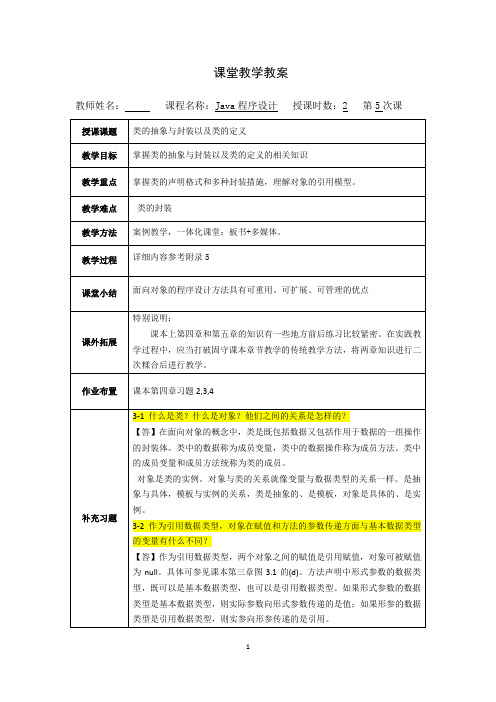
课堂教学教案教师姓名:课程名称:Java程序设计授课时数:2 第5次课附录54.1 抽象与封装4.1.1 抽象●所有编程语言都提供“抽象”功能。
●你所能解决问题的复杂程度取决于抽象的种类和质量。
●汇编语言对于计算机(机器语言)是一步很小的抽象。
●过程化语言(高级语言)对于汇编语言的抽象迈了一大步。
但你所考虑的仍然是机器的结构而非问题的结构。
●面向对象方法为程序员提供了一种表示问题空间元素的全新的方法,而且不受问题类型的约束。
4.1.2 对象●问题空间元素→方法空间中的表示:对象●“对象”是现实世界的实体或概念在计算机逻辑中的抽象表示。
●面向对象的程序设计是以要解决的问题中所涉及到的各种对象为主要考虑因素。
●面向对象语言更加贴近人的思维方式。
OOP允许用问题空间中的术语来描述问题。
●在面向对象程序设计中还需要一些其他对象,而它们没有在问题空间的对应体。
●“对象”就象是一台小“计算机”:●对象有状态&& 有你要求它执行的操作●现实世界中的对象:它们都有自己的状态&& 它们又都有自己的行为●程序中的对象:用属性表示状态&& 用方法(代码)实现行为●封装——信息的隐藏●“ 封装”是一种组织软件的方法。
其基本思想是把客观世界中联系紧密的元素及相关操作组织在一起,使其相互关系隐藏在内部,而对外仅仅表现为与其他封装体间的接口。
从而构造出具有独立含义的软件实现。
●封装并不是一个新的概念,但在面向对象的程序设计中提出了一种全新的封装方法-类●每个类里都封装了相关的数据和操作。
在实际的开发过程中,类多用来构建系统内部的模块。
●由于封装特性把类内的数据保护得很严密,模块与模块间仅通过严格控制的界面进行交互,使它们间耦合和交叉大大减少,从而降低了开发过程的复杂性,提高了效率和质量,减少了可能的错误,同时也保证了程序中数据的完整性和安全性。
●封装——软件复用●封装使得对象:对内成为一个结构完整、可自我管理、自我平衡、高度集中的整体。
- 1、下载文档前请自行甄别文档内容的完整性,平台不提供额外的编辑、内容补充、找答案等附加服务。
- 2、"仅部分预览"的文档,不可在线预览部分如存在完整性等问题,可反馈申请退款(可完整预览的文档不适用该条件!)。
- 3、如文档侵犯您的权益,请联系客服反馈,我们会尽快为您处理(人工客服工作时间:9:00-18:30)。
教案首页周次 日期 课时序课题字符串处理 字符串是 Java 应用程序中最常用的数据类型,要求学生 能够理解字符串的基本概念和使用情况 String、StringBuffer 类;命令行参数 String、StringBuffer 类;命令行参数 第六章 字符串处理(3*45‘) 第一节 类 String 字符串(40‘) 第二节 类 StringBuffer 字符串(40‘) 第三节 main 方法的命令行参数(25‘) 第四节 字符串应用举例(30‘)教学目的 要 重 难 求 点 点教学过程 设 及 时间分配 计教学场所 或教学方法 作 业使用 教具课 后 记授课教师1第六章 字符串处理从本章开始介绍的是 Java 的应用,与前面几章有所不同,以后将主要讲授程 序范例,让学生增强应用能力,而此前主要是讲授理论知识为主。
字符串是字符的序列,它是组织字符的基本数据结构。
对于大多数程序员来说 都是很重要的。
Java 将字符串当作对象来处理。
Java 语言中的包 ng 封装了 final 类 String 和 StringBuffer 类。
6.1 6.1.1类 String 字符串 类 String 字符串的定义String 类是字符串常量类,String 对象建立后不能修改。
以前使用的每个字符 串常量(用双引号括起来的一串字符串)实际上都是 String 对象。
构造方法有: String() Initializes a newly created String object so that it represents an empty character sequence.String(byte[] bytes) Construct a new String by converting the specified array of bytes using the platform's default character encoding.String(byte[] ascii, int hibyte) Deprecated. This method does not properly convert bytes into characters. As of JDK 1.1, the preferred way to do this is via the String constructors that take a character-encoding name or that use the platform's default encoding.String(byte[] bytes, int offset, int length) Construct a new String by converting the specified subarray of bytes2using the platform's default character encoding.String(byte[] ascii, int hibyte, int offset, int count) Deprecated. This method does not properly convert bytes into characters. As of JDK 1.1, the preferred way to do this is via the String constructors that take a character-encoding name or that use the platform's default encoding.String(byte[] bytes, int offset, int length, String enc) Construct a new String by converting the specified subarray of bytes using the specified character encoding.String(byte[] bytes, String enc) Construct a new String by converting the specified array of bytes using the specified character encoding.String(char[] value) Allocates a new String so that it represents the sequence of characters currently contained in the character array argument.String(char[] value, int offset, int count) Allocates a new String that contains characters from a subarray of the character array argument.String(String value) Initializes a newly created String object so that it represents the same sequence of characters as the argument; in other words, the newly created string is a copy of the argument string.String(StringBuffer buffer) Allocates a new string that contains the sequence of characters currently3contained in the string buffer argument.利用这些构造函数来定义 String 对象。
例题。
讲授书上 6.1 例题。
6.1.2 类 String 的常用方法学习好程序设计,主要是靠自己自学,老师教基础,给学生打根基。
因为新的 语言,新的技术每天都在出现,自己不学,永远会落后。
具体的 Java 语言的应用,学生应该自己多看看帮助,虽然是英文,但也必须 多看,这样才能提高。
A:类 String 字符串的比较 : 有如下方法,对每个方法做介绍 public boolean equals(Object anObject) 比较两个字符串是否相同, 大小写有区别。
如果相同, 则返回 true, 否则返回 false。
这里说明一下“ ” 方法的区别。
这里说明一下“=”号和 equal 方法的区别。
Compares this string to the specified object. The result is true if and only if the argument is not null and is a String object that represents the same sequence of characters as this object.Overrides: equals in class Object Parameters: anObject - the object to compare this String against.Returns: true if the String are equal; false otherwise.public boolean equalsIgnoreCase(String anotherString) 比较两个字符串是否相同,但是忽略大小写。
如果相同,返回 true,如果不相同,4返回 false。
Compares this String to another String, ignoring case considerations. Two strings are considered equal ignoring case if they are of the same length, and corresponding characters in the two strings are equal ignoring case.Parameters: anotherString - the String to compare this String against.Returns: true if the argument is not null and the Strings are equal, ignoring case; false otherwise. public int compareTo(String anotherString) 比较两个字符串大小, 通过返回的整数值指明当前字符串与参数字符串的大小关 系。
若调用的串对象比参数串对象大,返回正整数;反之,返回负整数。
相等返 回 0。
返回情况:若比较的两个字符串有不同的字符,则总左边数起的第一个不同字符 的大小即为返回值; 若比较的两个字符串的各个位置的字符都相同, 而长度不同, 则返回值为长度差。
Compares two strings lexicographically. The comparison is based on the Unicode value of each character in the strings. The character sequence represented by this String object is compared lexicographically to the character sequence represented by the argument string. The result is a negative integer if this String object lexicographically precedes the argument string. The result is a positive integer if this String object lexicographically follows the argument string. The result is zero if the strings are equal; compareTo returns 0 exactly when the equals(Object) method would return true.This is the definition of lexicographic ordering. If two strings are different, then either they have different characters at some index that is a valid index for both strings, or their lengths are different, or both. If they have different characters at one or more index positions, let k be the smallest such index; then the string5whose character at position k has the smaller value, as determined by using the < operator, lexicographically precedes the other string. In this case, compareTo returns the difference of the two character values at position k in the two string -- that is, the value:this.charAt(k)-anotherString.charAt(k)If there is no index position at which they differ, then the shorter string lexicographically precedes the longer string. In this case, compareTo returns the difference of the lengths of the strings -- that is, the value:this.length()-anotherString.length()Parameters: anotherString - the String to be compared.Returns: the value 0 if the argument string is equal to this string; a value less than 0 if this string is lexicographically less than the string argument; and a value greater than 0 if this string is lexicographically greater than the string argument.Throws: NullPointerException - if anotherString is null. public boolean startsWith(String prefix) 比较当前字符串是否是以 prefix 开头。
